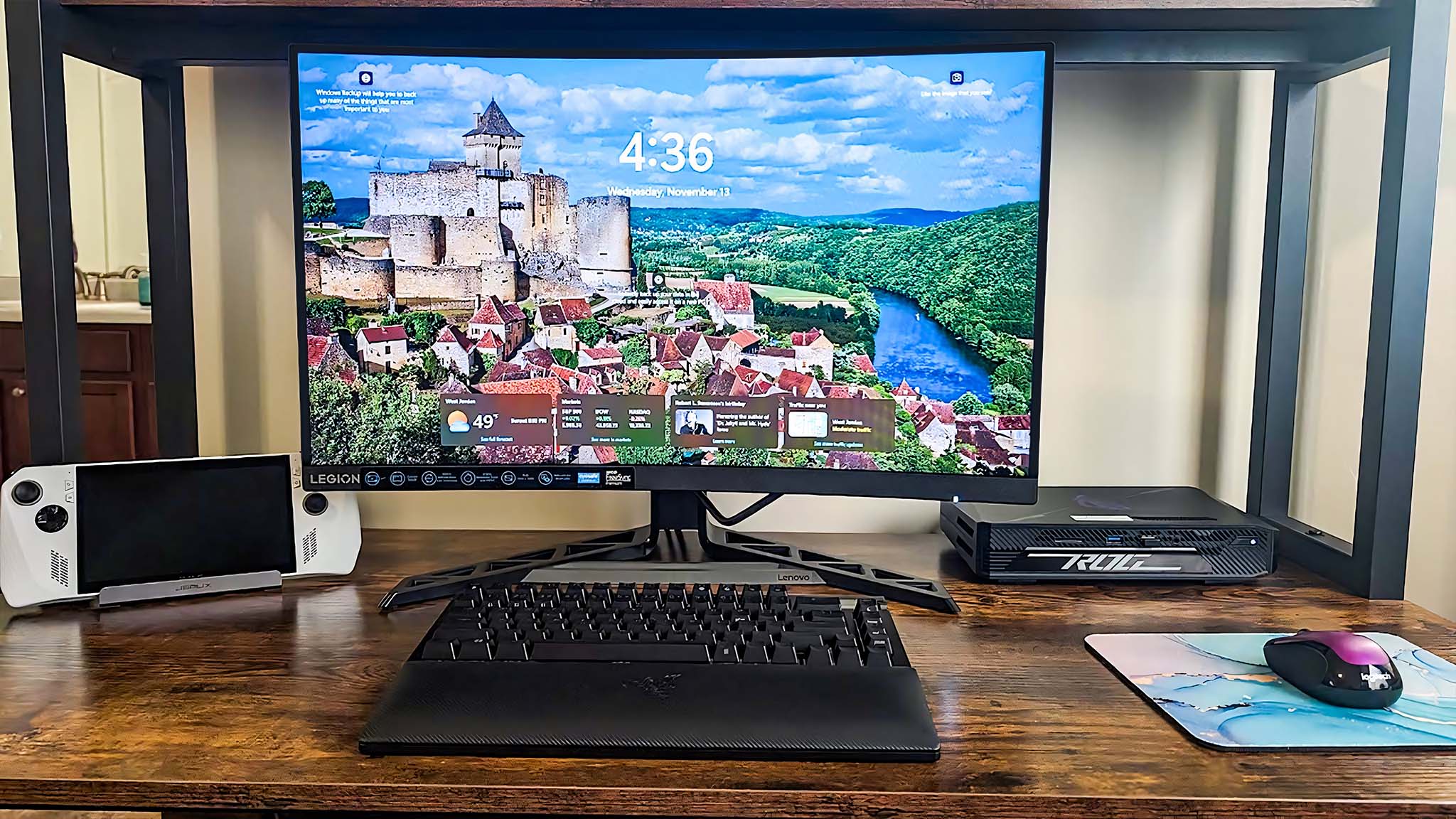
1. Pricing & specs
2. Setup & design
3. Picture quality
4. OSD
5. Speakers
6. Competition
7. Scorecard
8. Should you buy it?
There are many options to choose from when looking for a gaming monitor, but few strike a good balance of offering great features at an affordable price. That's one way that the Lenovo Legion R27fc-30 Curved Gaming Monitor stands out from competitors. It's a very good value.
Over the course of the last two weeks, I've been using the Lenovo Legion R27fc-30 as my main monitor for both work and gaming. I've also run it through a few tests to analyze its performance. Here's what I've discovered.
Lenovo Legion R27fc-30: Price and specs
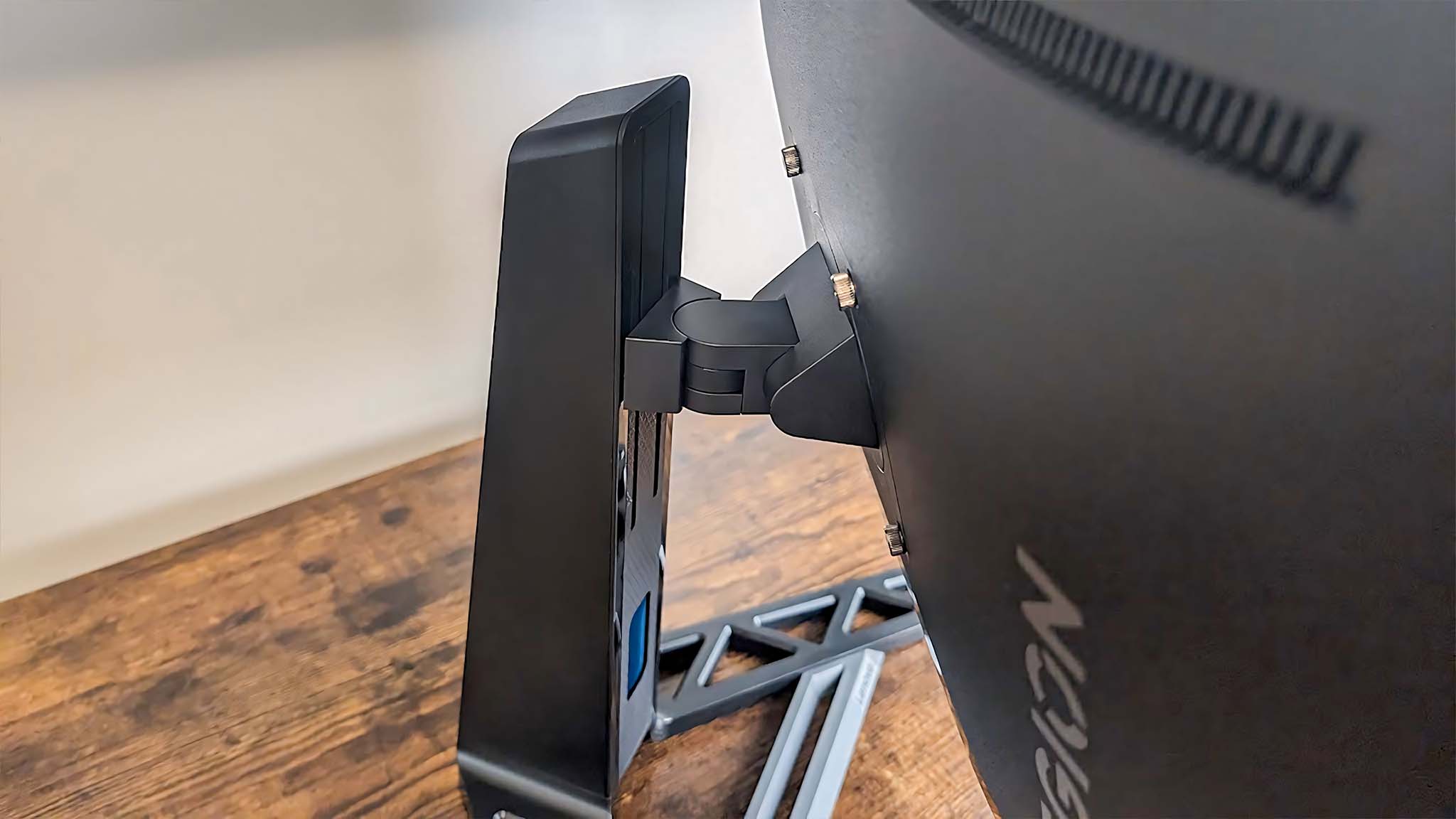
Pricing & specifications highlights
- Lenovo is one of the top PC manufacturers on the market today, producing reliable products with plenty of conveniences.
- The R27fc-30 makes for a great 27-inch curved gaming monitor with its 240Hz, 0.5ms, and AMD FreeSync support.
- This monitor is very well priced given its specs, making this a great value purchase.
- You can buy it from Amazon or the Lenovo website.
- Value rating: 5/5
Price: $229.99 at Lenovo
Display size: 27 inches
Resolution: 1920 x 1080p, 16:9
Type: VA Curved 1500R
Refresh rate: 240Hz (280Hz Overclock)
Response time: 0.5ms
VRR technology: AMD FreeSync
Viewing angle: 178°/ 178°
Brightness: 350 nits
HDR support: None
Camera: None
Speakers: 2x 3W
Ports: 2x HDMI 2.1, 1x DisplayPort 1.4, 1x audio out, 1x power port, 1x Kensington Lock
Dimensions (head only): 82.7 x 367.3 x 610.3mm (3.26 x 14.46 x 24.03in)
Weight (head only): 4.3 kg (9.5 lbs)
Lenovo is one of the top PC manufacturers on the market today, with many of its products being used in office settings as well as homes. Legion is the company's gaming sub-brand, specializing in gaming laptops, gaming desktops, gaming monitors, and even the Legion Go gaming handheld. From my own experiences, I can say it's a respectable brand that produces quality products that last for a long time.
The Legion R27fc-30 gaming monitor provides mid-range gaming specs offered at a more budget-friendly price. Some 27-inch curved gaming monitors with fast response times and fast refresh rates can sell for $300 and up, but the R27fc-30 is more affordable with its $229.99 price point. I've even seen it on sale for just $175.49 at Lenovo.com.
This particular monitor can reach a very fast 240Hz, but can be overclocked to 280Hz if desired. It also produces a super speedy response time of just 0.5ms to keep up with your gaming needs. If you have a computer with a compatible AMD GPU in it, you can also make use of AMD FreeSync to help your game look even smoother on the VA display.
You can purchase the Legion R27fc-30 curved gaming monitor from Amazon or the Lenovo website.
Lenovo Legion R27fc-30 — What's in the box?
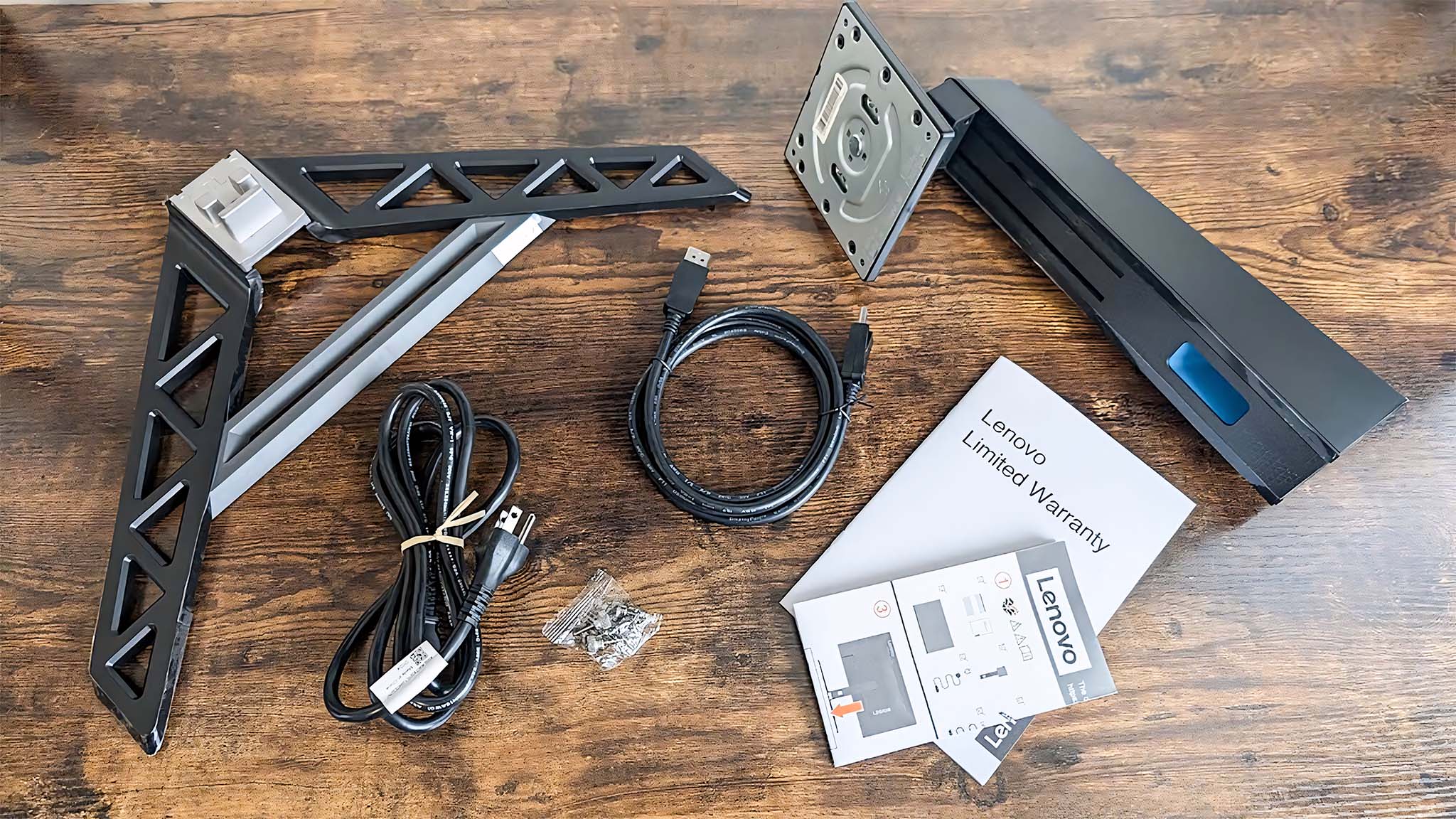
When I opened the box, I found the Lenovo Legion R27fc-30 monitor, a triangular base, an adjustable stand, a power cable, a DisplayPort cable, four screws, a Lenovo Warranty manual, and an illustrated set up guide.
Lenovo Legion R27fc-30 : Setup and design
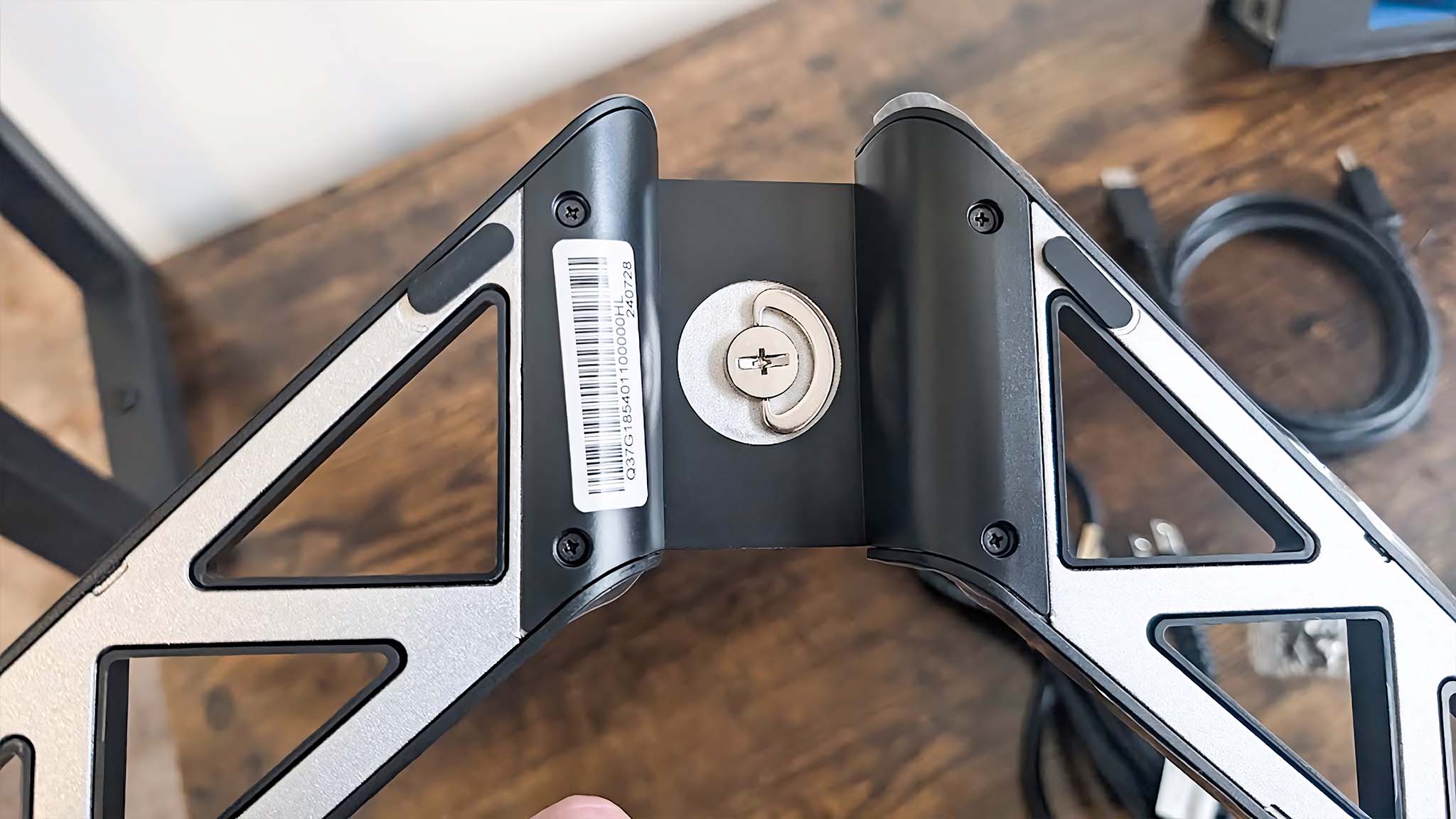
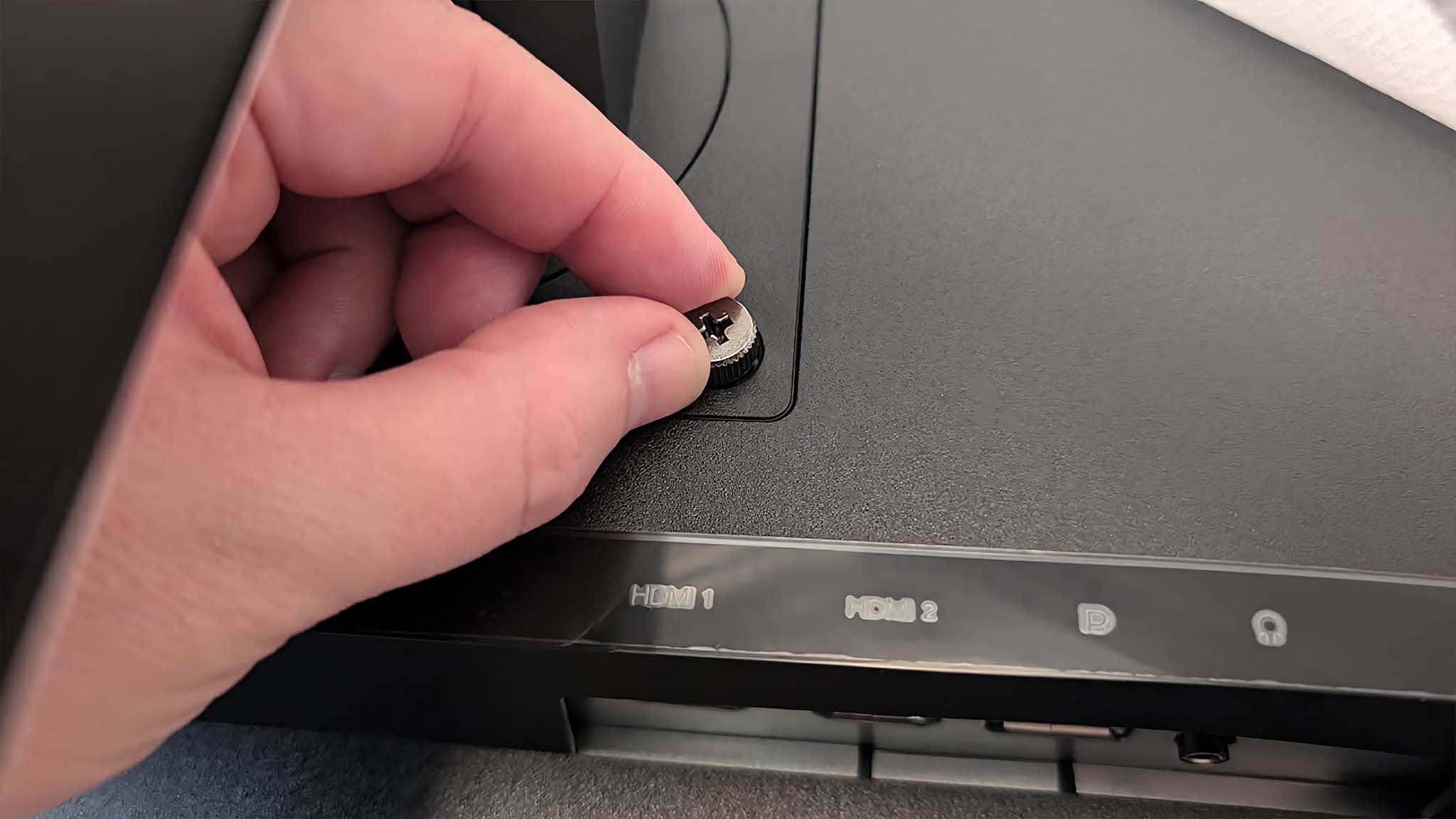
Setup and design highlights
- Assembly and set up is a breeze, with no tools needed.
- The triangular base is extremely sturdy and prevents the display from wobbling, but it takes up a lot of room.
- An adjustable stand and monitor make it easy to get the best viewing angle.
- The ports, the OSD controls, and the power button are all easy to reach.
- Design rating: 5/5
As with most gaming monitors on the market today, this one doesn't technically require any tools to assemble. It comes with an illustrated step-by-step manual to help you get everything set up in just a few minutes.
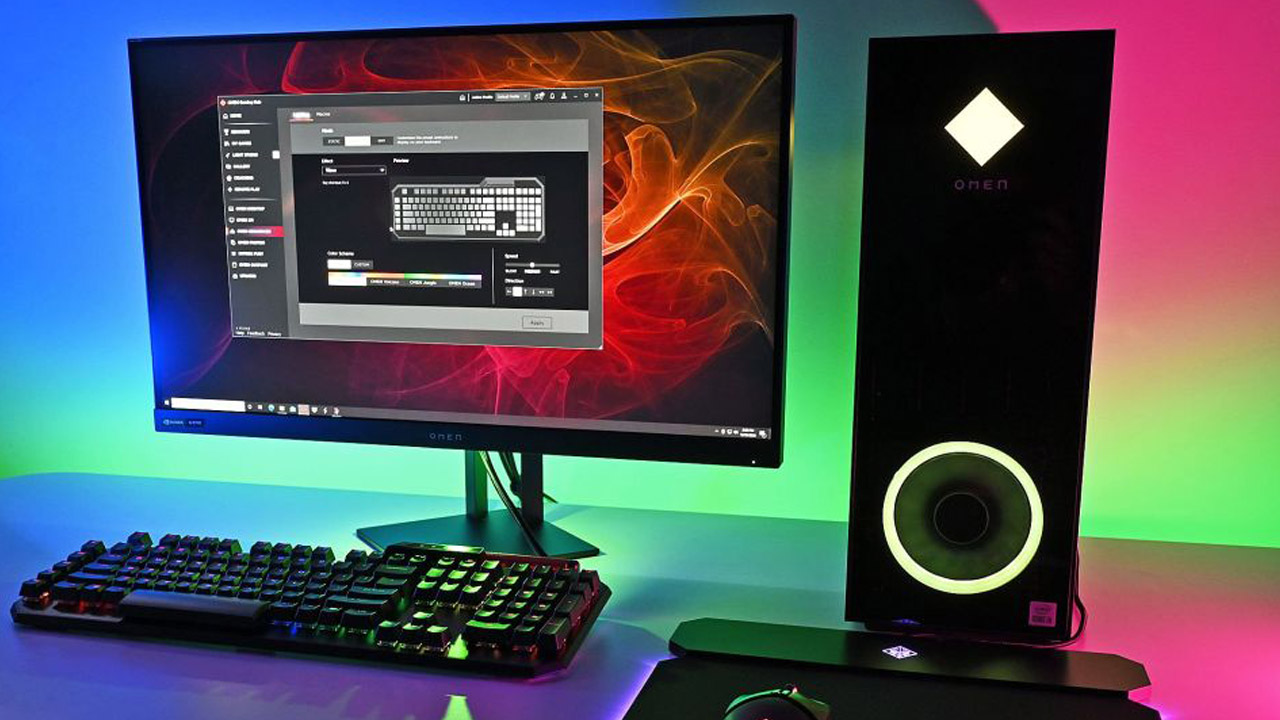
• Best Xbox / PC headsets in 2024
• Best upcoming Xbox / PC games
• Best Xbox controllers
• Best Xbox accessories
• Best small gaming PCs
• Best gaming laptops in 2024
• Best gaming handhelds 2024
There is a built-in screw in the stand for connecting the base and stand together. However, when connecting the stand to the back of the monitor, I did need to screw four screws into position. These screws have wide sides with ridges so that it's easy to screw them in by hand, but you might want to tighten them with a screwdriver for an added measure of assurance.
With the monitor assembled, I simply threaded the included DisplayPort cable and power cable through the cable tidy hole in the stand and then plugged everything in. It's not the cleanest setup you'll find, but it does make cable management easier without requiring any additional accessories.
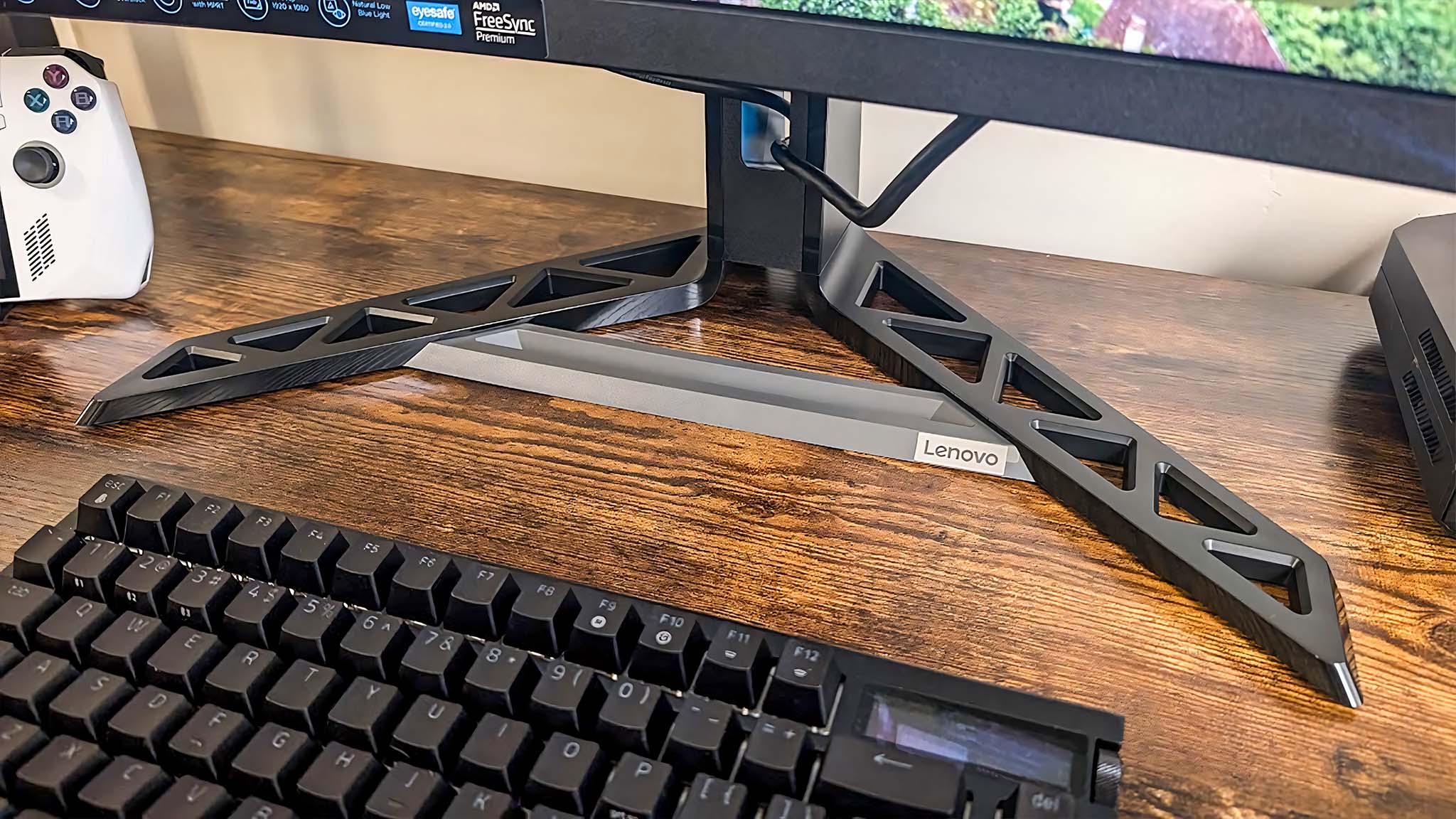
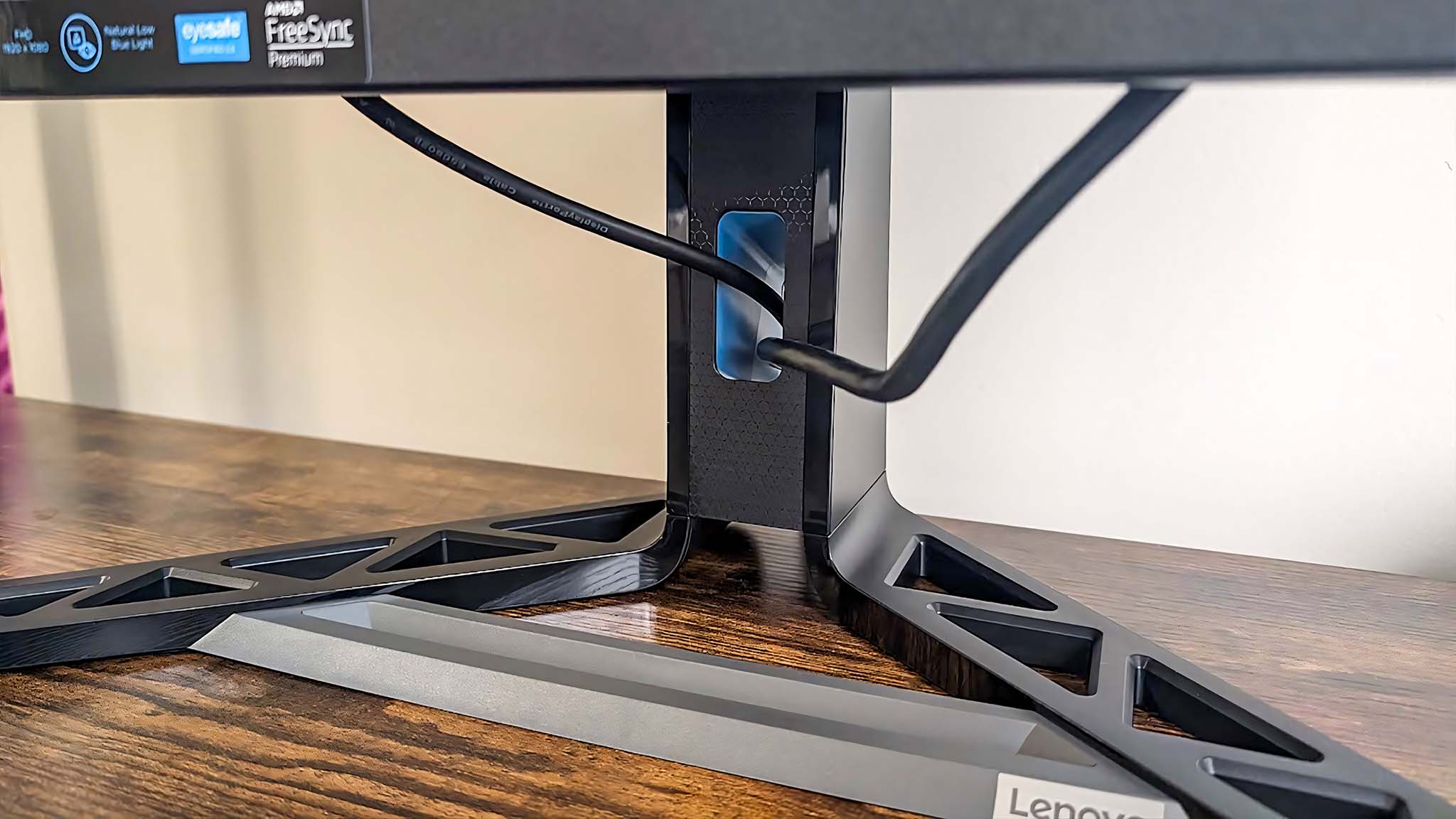
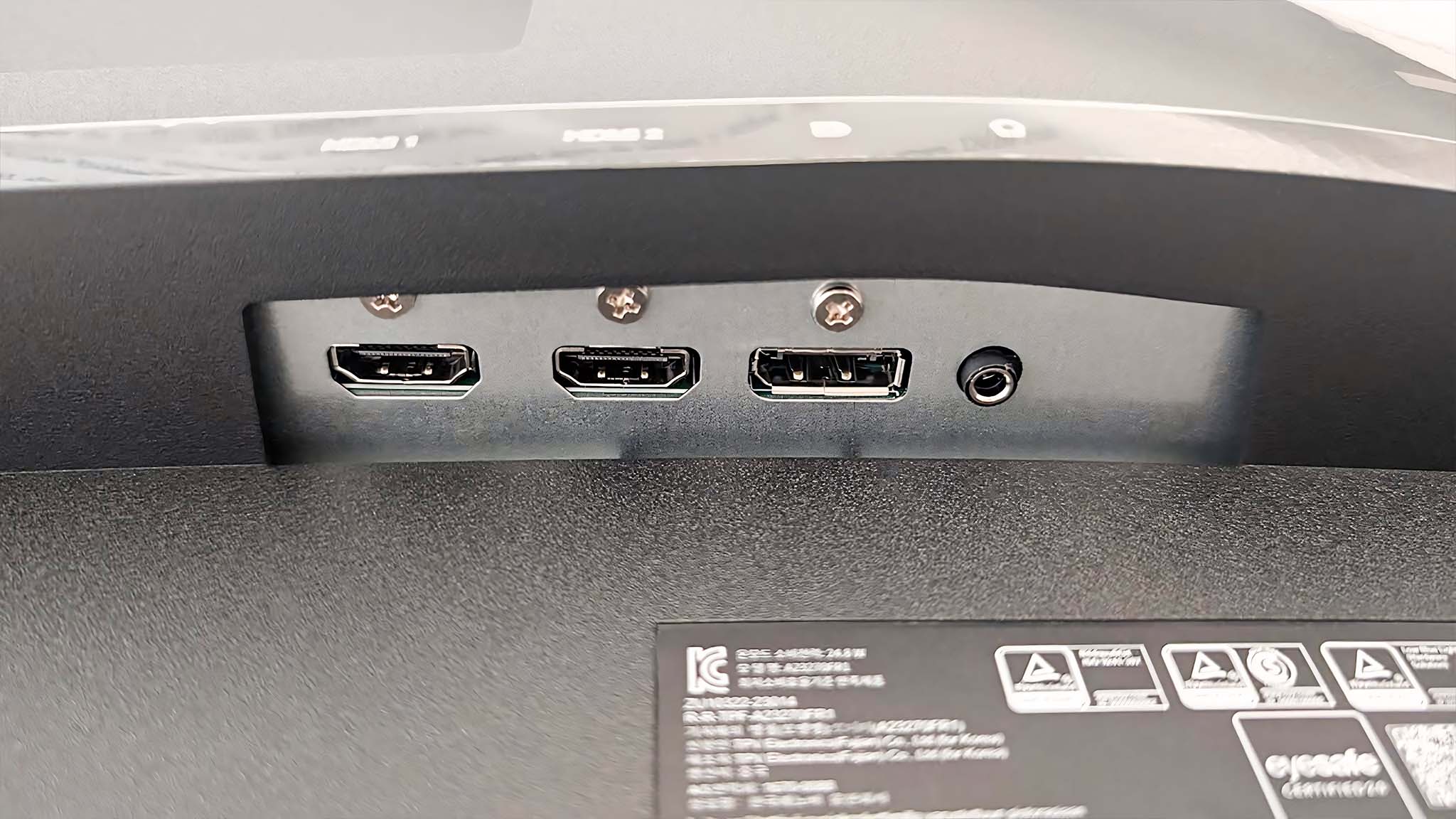
While the Legion R27fc-30 isn't the sleekest gaming monitor on the market, the black plastic base and stand look good and are both very sturdy and reliable. I never had to worry about the monitor wobbling. However, the triangular base does take up a lot of room, which can make it harder to fit other devices and accessories on the desk. For instance, I had to push my ROG Ally docking station further to the left so it wouldn't get in the way of the base plastic.
The stand itself is fantastic, letting me get the display angled at just the right position for my needs. I can raise the monitor six-inches away from the desk or lower it to just above the base legs. Additionally, the monitor can be tilted forward and backward, rotated side to side, and pivoted. However, since the monitor is relatively wide, it cannot fully be turned to portrait orientation when attached to this stand.
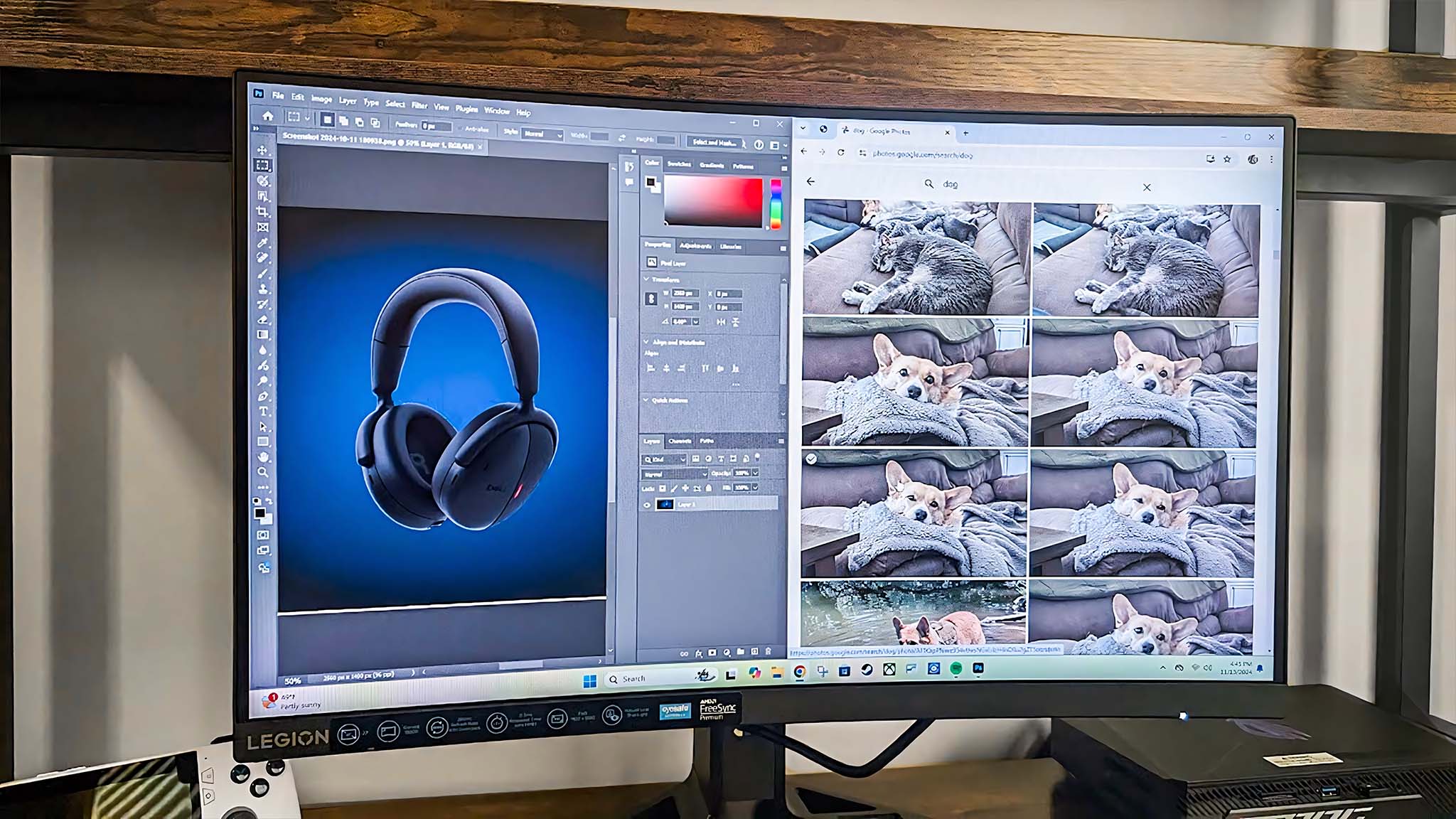
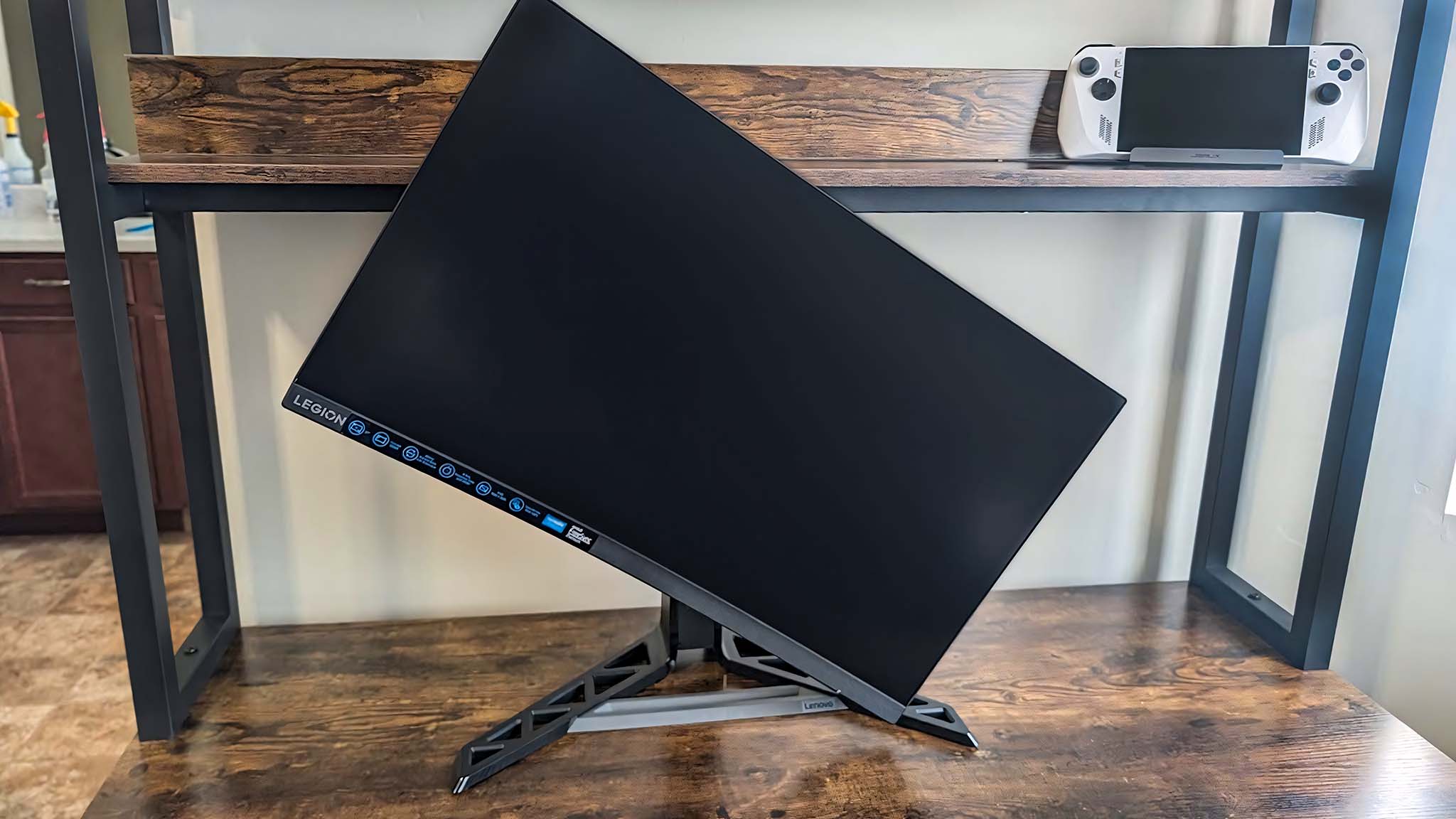
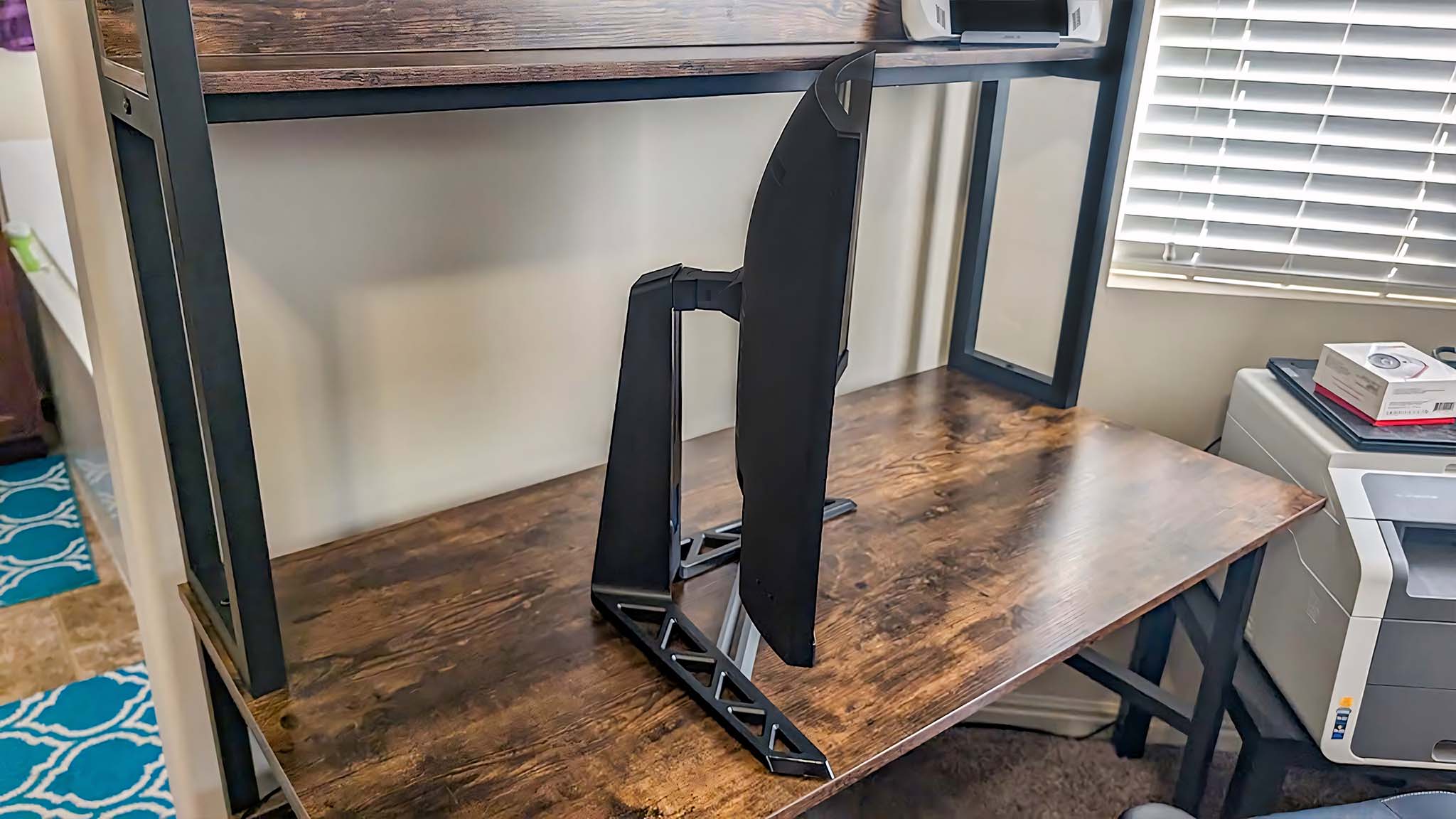
The display itself isn't super thin, but that's to be expected given this is a 1500R curved monitor. I'll dive into display quality more in a later section, but suffice it to say that the 27-inch panel is large enough for very easy multitasking between two browser windows or programs. It's also easy to reach the OSD buttons and power button on the backside.
Port wise, the R27fc-30 offers two HDMI 2.1 ports, a DisplayPort 1.4, and an audio jack. This being the case, you'll need to rely on your PC for any USB-A or USB-C ports for your accessories. Alternatively, you could look at our list of the best Thunderbolt hubs and docking stations if you need something to handle your connection needs.
Lenovo Legion R27fc-30: Picture quality
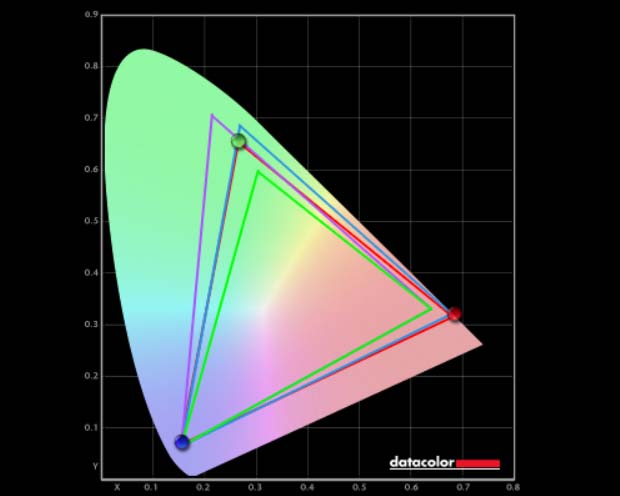
Picture quality highlights
- The Lenovo Legion R27fc-30 produced 100% of sRGB, 82% of AdobeRGB, 88% of P3 in a color gamut test.
- This monitor offers great contrast and gets very close to offering true black.
- It doesn't get very bright, so it's best not to use it in an overly bright room.
- A high 240Hz refresh rate with 0.5ms response time and AMD FreeSync allow for excellent motion clarity.
- Text doesn't always look super crisp despite the 1920x1080 resolution.
- Display rating: 4/5
This monitor is respectable, but not stellar as far as picture quality goes. I ran color gamut tests on each of this display's seven default modes and the result was usually 100% of sRGB, 82% of AdobeRGB, 88% of P3, but with that last one sometimes slipping down to 87% of P3. These aren't the most fantastic results we've seen in a gaming monitor, but it is to be expected from a VA panel. You'd get more vibrant colors from an IPS panel, and definitely better coloring from an HDR OLED display.
I also ran a brightness and contrast test and found that the monitor didn't quite reach the 350nits of brightness that Lenovo claims it can. It peaked out at 321nits, which is a bit dimmer. This being the case, this monitor isn't ideal for an overly bright room. However, the monitor did a decent job with contrast, being very close to true black. This helps details look more dynamic since there's more contrast between objects shown in an image.
To test this screen, I played STALKER 2: Heart of Chornobyl and Cyberpunk 2077 for a couple of hours each. I didn't see any screen tearing and imagery came through very smoothly during my play sessions. As with most gaming monitors, in order to change to 240Hz, I had to right-click on the desktop background, select Display Settings, click on Advanced Display, and then use the drop-down menu near the bottom of the window to change my refresh rate to 239.65Hz. The monitor can also be overclocked to hit 280Hz (using the OSD menu), but I don't suggest leaving it on that setting as this can wear the monitor out faster.
One bad thing I have noticed is that this 1920x1080 resolution panel is not as crisp as I'd like it to be. When reading online articles are typing up posts, it's not uncommon for me to find areas on the screen where the text is a little blurred compared to other areas. One spot had me blinking for a couple of seconds until I realized that it was the display and not my eyes. It's not the worst thing ever, but notable when the text lines up in certain places.
Lenovo Legion R27fc-30: OSD and controls
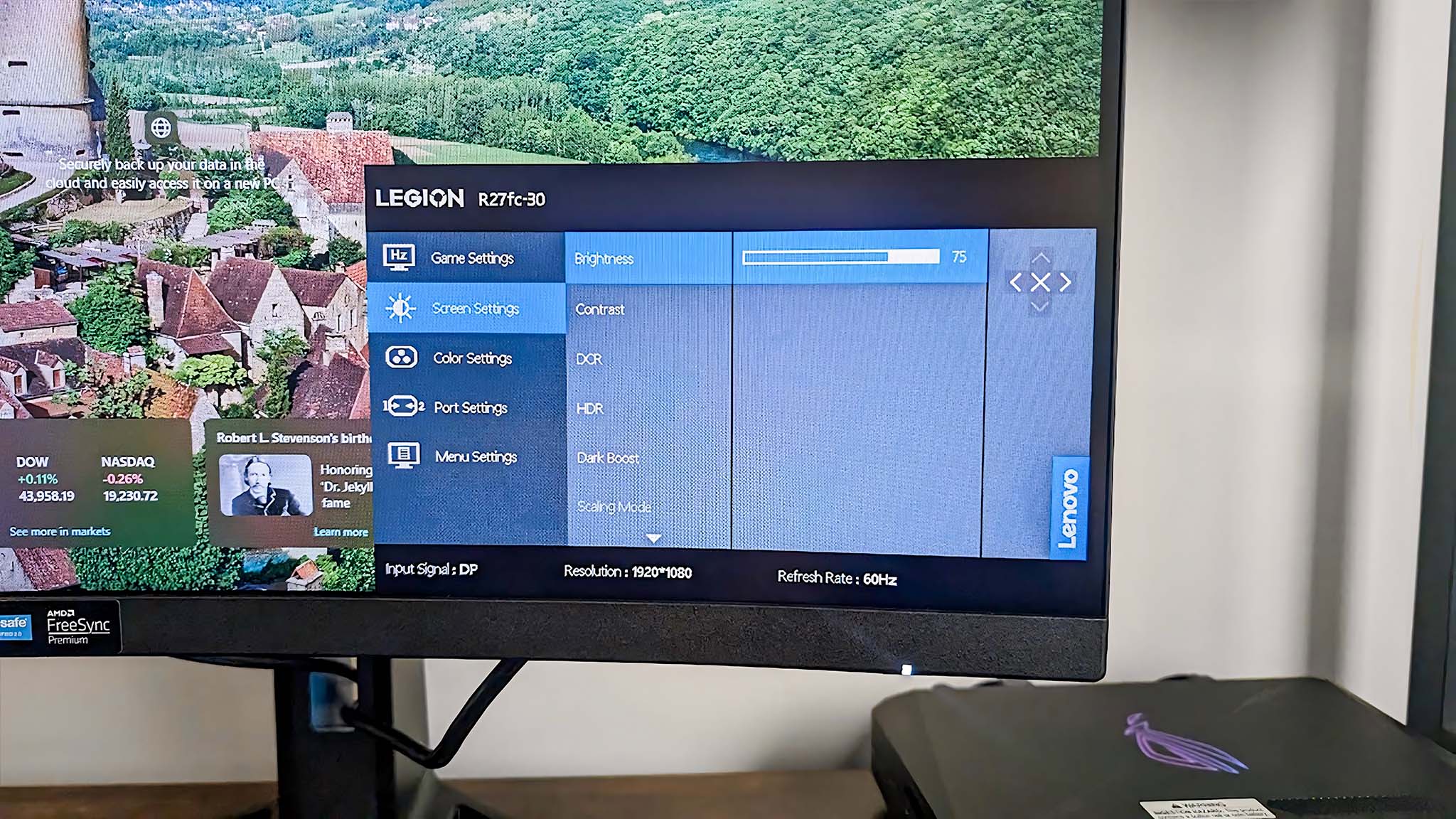
OSD and controls highlights
- The buttons on the back of the monitor are easy to reach and control.
- An intuitive OSD layout makes it easy to change settings and find the options you're looking for.
- You can also download Lenovo Artery to help you control monitor settings via a program rather than the OSD.
- OSD rating: 5/5
A large blue multi-directional button on the backside of the R27fc-30 serves as the OSD (on-screen display) controls. Tapping up or down immediately allows me to adjust brightness, tapping left or right adjusts volume, and pressing the button at the center brings up the full OSD menu.
As is usually the case, it's here in the OSD that I can change to different monitor modes, enable/disable AMD FreeSync, adjust saturation, alter port settings, and more. Overall, the OSD is very easy to work with, thanks to its simple layout. It only took a few minutes for me to feel comfortable navigating around and pressing the proper buttons.
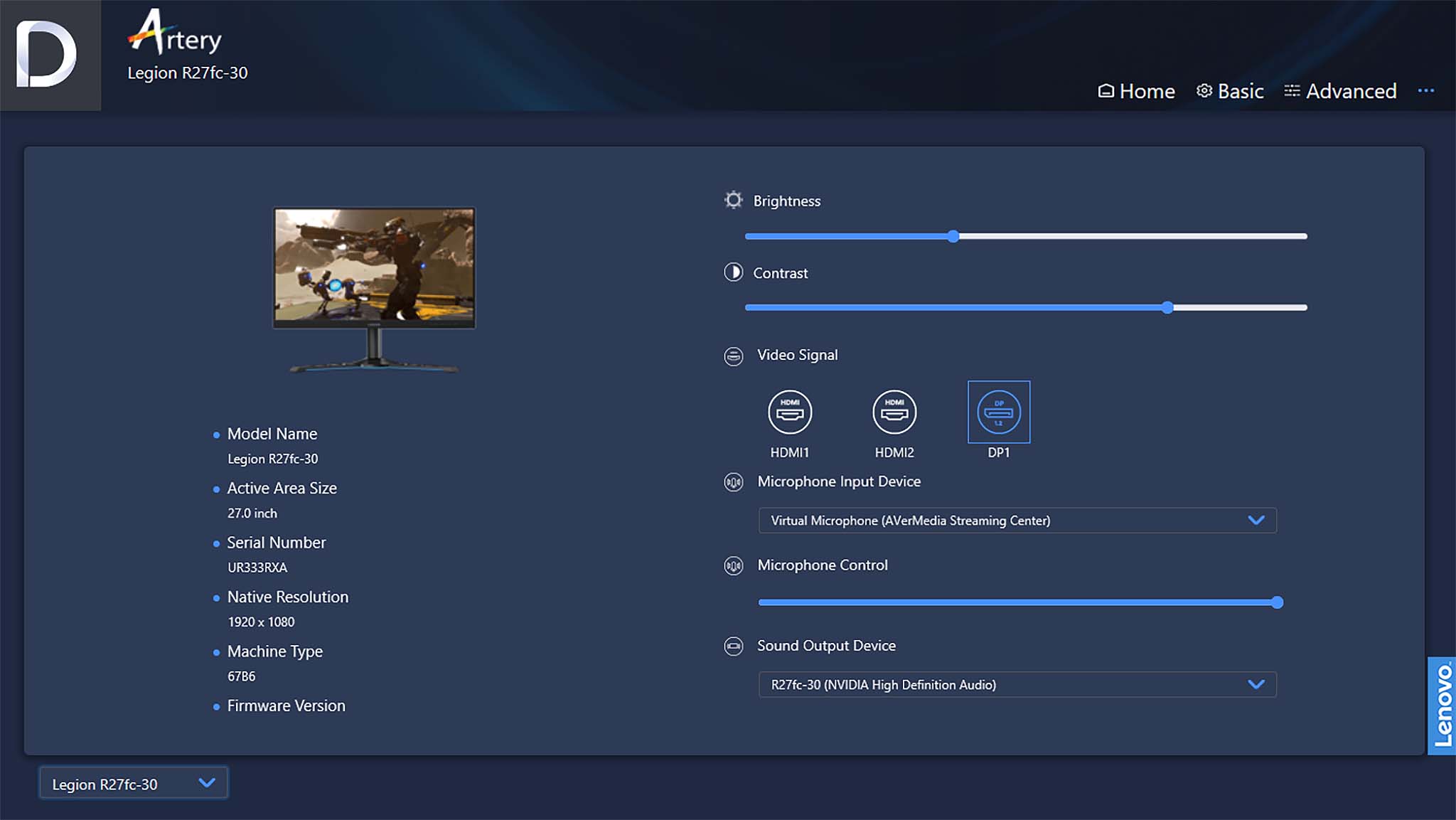
If you prefer to use your mouse when changing monitor settings, then you might want to download Lenovo Artery from the Lenovo website. This is technically a program intended for more creative-focused Lenovo monitors, but it works well with this gaming one. After I had downloaded the software, I was able to adjust contrast and brightness using sliders. This program also makes it easy to swap between inputs with just the press of an icon.
Lenovo Legion R27fc-30: Speakers
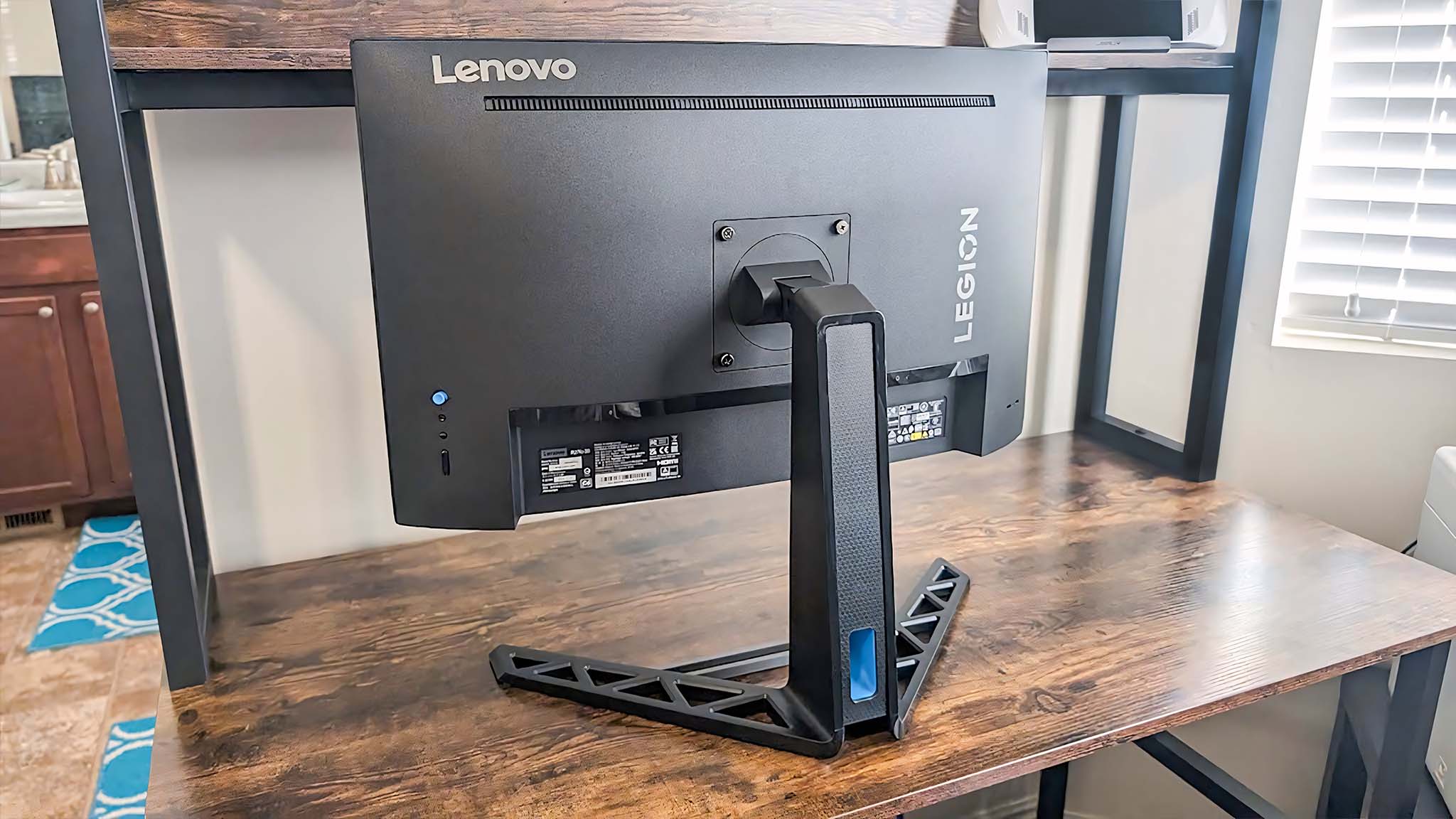
Speakers highlights
- The Legion R27fc-30 features two built-in 3W speakers.
- Speaker quality really isn't very good, so you'll want to use a headset or external speakers for better quality.
- Speakers rating: 3/5
Many gaming monitors do not come with built-in speakers, and those that do usually don't offer the best audio quality. Unfortunately, the Legion R27fc-30 is no exception here.
There are two 3W speakers located on the top backside of the display. Whenever I played video games or listened to music, the audio that issued from this area sounded distant and muffled. It was such a bad listening experience that I immediately paused Spotify shortly after hearing the speakers for the first time and went searching in my house for better options.
If you want to get a fuller sound experience, you'll want to connect this monitor to some external PC speakers or else use one of the best gaming headsets out there.
Lenovo Legion R27fc-30: Competition
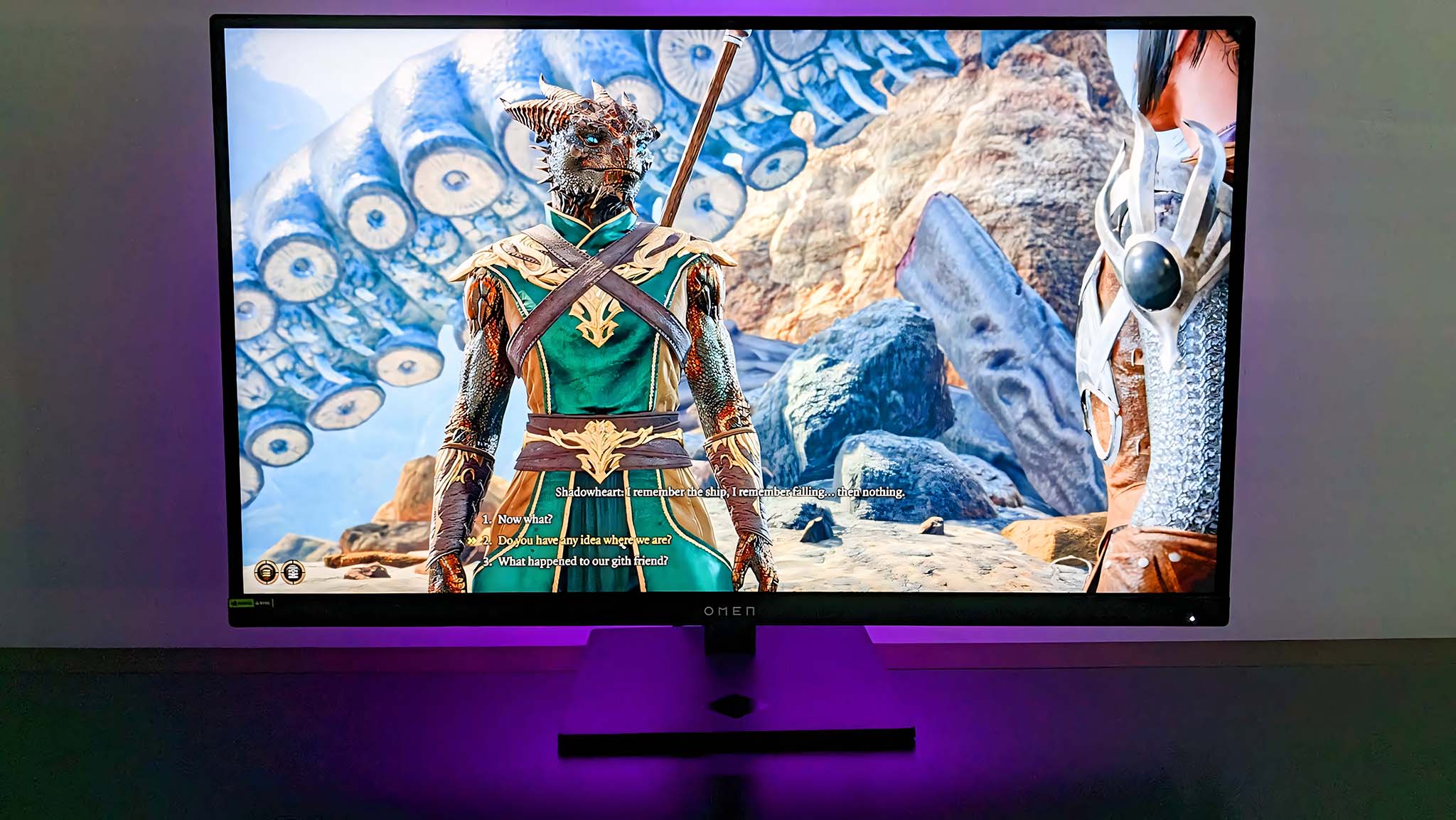
If you don't specifically need a curved gaming monitor, you might want to check out my Titan Army P2510S review. This is technically a budget monitor, and it definitely doesn't have as good of base/stand quality as the Legion R27fc-30. However, it does offer the same 240Hz refresh rate, 1ms response time, AMD FreeSync, and HDR10. It sells for $299.99 at Amazon.
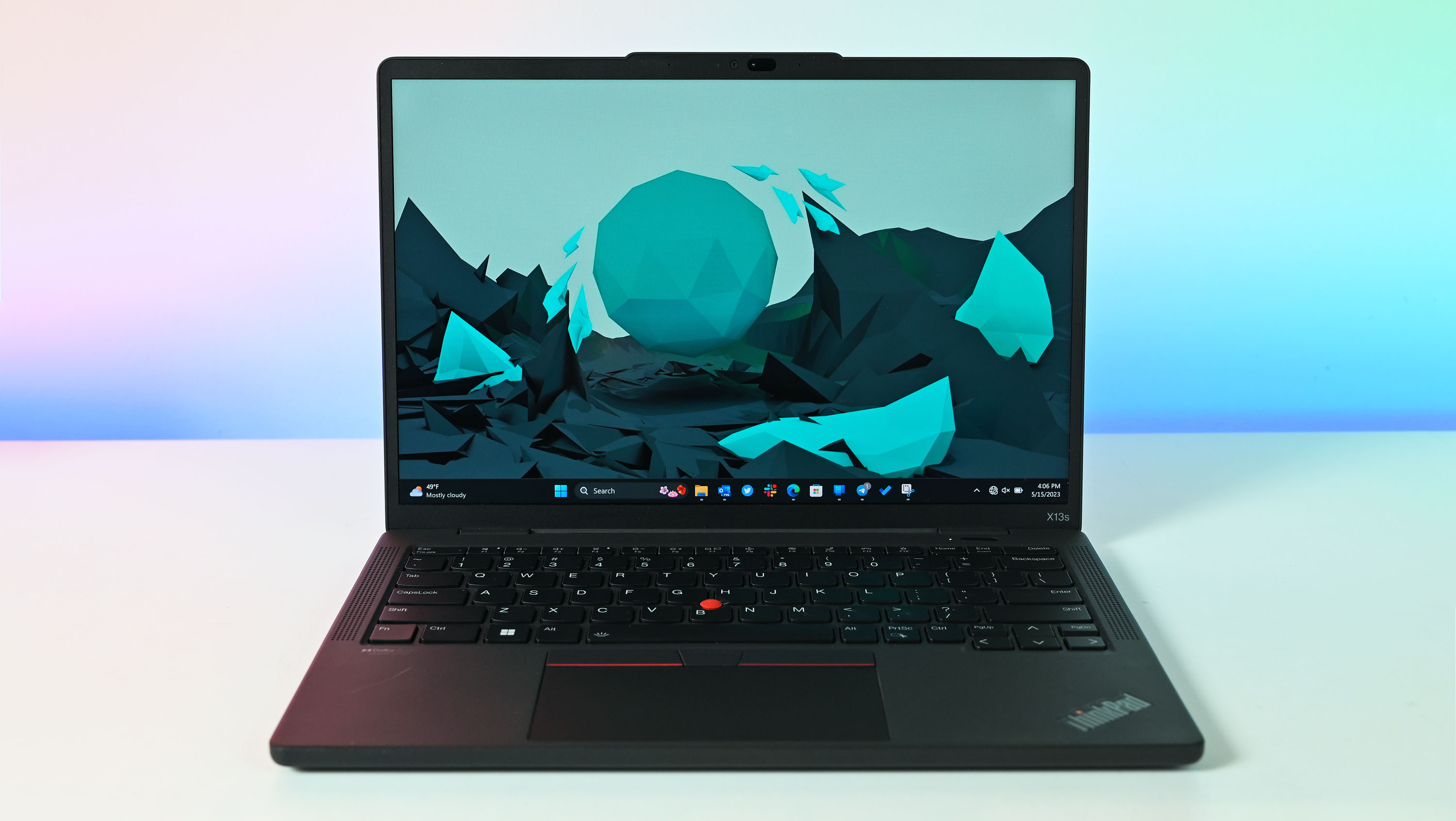
- Best gaming laptops
- Best Windows laptops
- Laptop review and buying guides
- Best gaming headsets
- Best gaming monitors
Another non-curved budget gaming monitor can be seen in my Monoprice Dark Matter 27" QHD review. While it definitely isn't the nicest monitor out there, it is very affordable while offering 165Hz refresh rate with 2ms response time and also supporting both AMD FreeSync and NVIDIA G-Sync. The biggest drawbacks are that it has a strange stand that is rather wobbly, and the screen doesn't get very bright. You can find it selling for $329.99 at Amazon.
Now, if you're willing to spend a little more for a gaming monitor, then you'll want to take a peak at my ASUS ROG Strix OLED review. This display offers a 27-inch WOLED that can reach up to 1440p, 240Hz, and 0.03ms. Motion clarity is very nice since it supports NVIDIA G-Sync. It sells for $699.99 at Walmart.
Anyone who's willing to spend a lot more for a high-quality monitor should take a look at my Alienware AW2725DF review. I was blown away by this 26.7-inch QD-OLED panel's motion clarity, aided by an extremely high 360Hz refresh rate, a speedy 0.03ms response time, and AMD FreeSync. It sells for $734.99 at Dell.
Lenovo Legion R27fc-30: Scorecard
Lenovo Legion R27fc-30: Should you buy it?
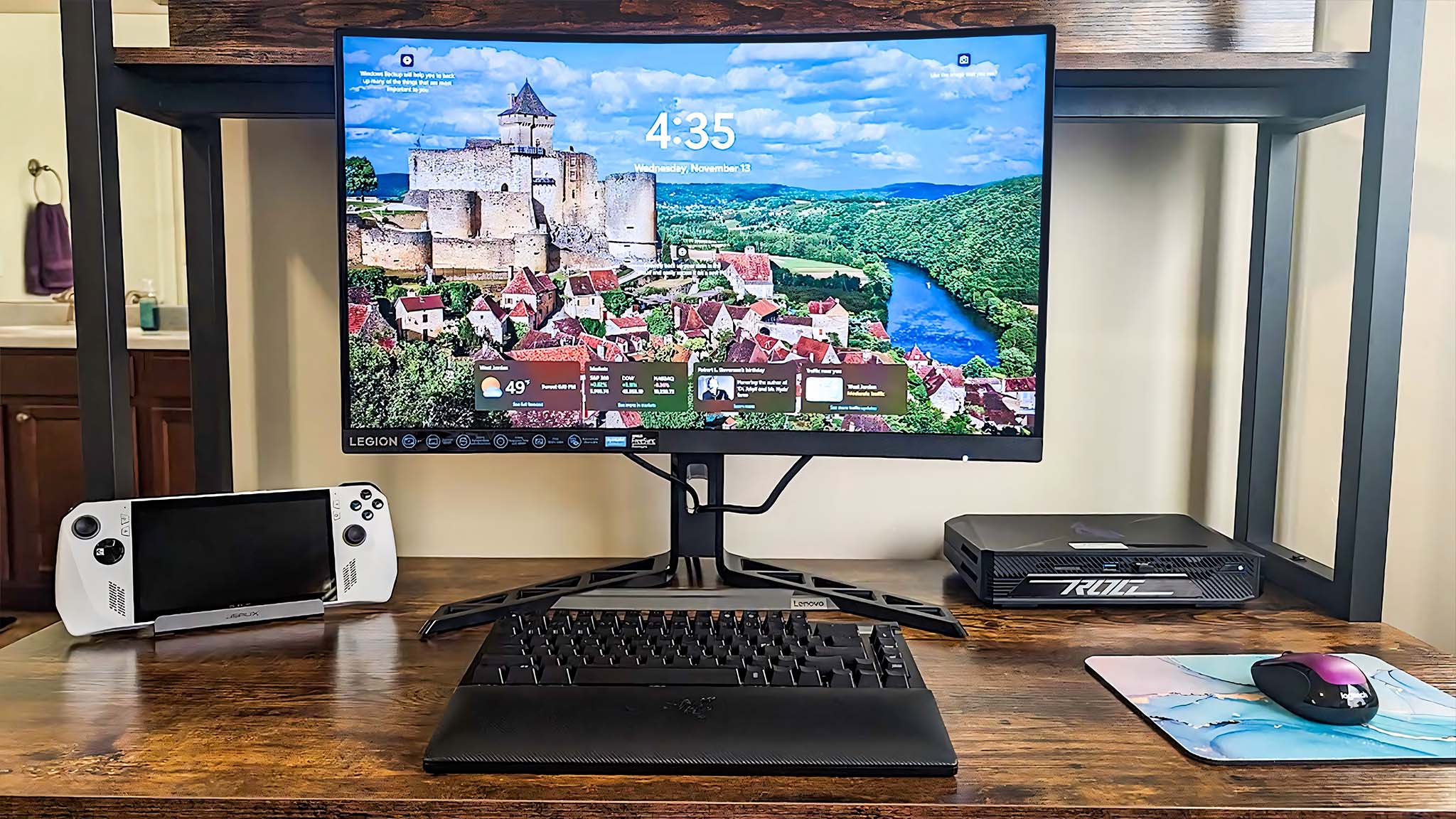
✅ You should buy this if...
- You're looking for a budget monitor with great motion clarity: Games can play very smoothly on this monitor since it can reach a peak of 240Hz (280Hz when overclocked), has 0.5ms response time, and supports AMD FreeSync. Despite that, it's still under $300.
- You'd like to get a monitor with a really adjustable stand: Being able to adjust the stand up and down or pivot the monitor every which way makes it easy to put this display at the perfect viewing angle.
❌ You should not buy this if...
- You specifically want a gaming monitor that supports G-Sync: If your gaming PC or gaming laptop has an NVIDIA GPU, then you'll be better served with a gaming monitor that supports NVIDIA G-Sync.
- You prefer using an OLED panel: There's no denying that OLED monitors offer superior color range and picture quality to IPS and VA panels. So, if you're willing to pay more, you should consider an OLED display.
When it comes to bang for your buck, the Lenovo Legion R27fc-30 is a fantastic gaming monitor. Despite having some more impressive specs (240Hz, 0.5ms, AMD FreeSync), it's more affordable than many other options. Plus, the stand can be adjusted in so many different ways that it's very easy to get this monitor set up and angled so you can get the best viewing experience possible.
However, it isn't perfect. While the base is very sturdy, it's large, triangular design does take up a lot of room, which might not be ideal for people with limited space. Unsurprisingly, the built-in speakers are very muffled and distant-sounding, but that's not unusual for a gaming monitor.
In the end, if you have the space for the R27fc-30, it is a great value buy that can serve your gaming needs well.
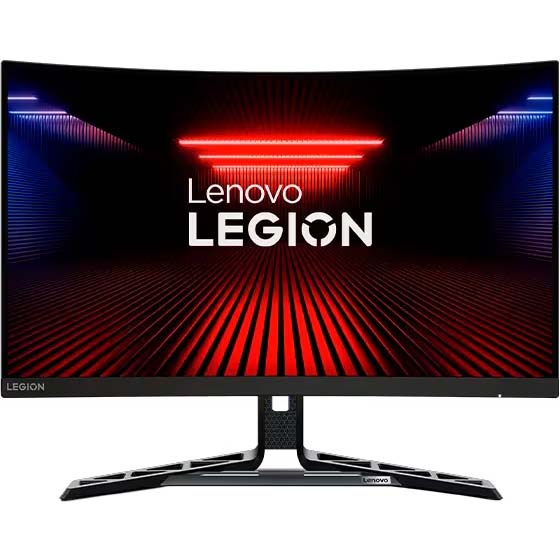
With its 240Hz refresh rate, 0.5ms response time, AMD FreeSync support, and R1500 curve, this gaming monitor is a fantastic budget option.







